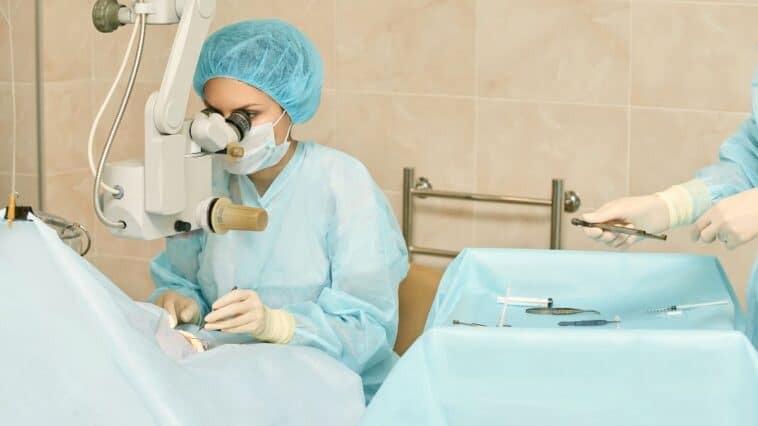Eye surgeries encompass various procedures that effectively treat various eye conditions. These surgeries cater to conditions like glaucoma, cataracts, retinal tears and detachments, wet age-related macular degeneration (AMD), diabetic retinopathy, and refractive errors such as nearsightedness and farsightedness.
Furthermore, eye surgeries address problems related to the eye muscles or the cornea, which is the transparent front structure of the eye. In cases where the cornea loses its transparency, a corneal transplant may be necessary. Eye muscle surgery is performed to align the eyes properly and alleviate double vision.
Tumors can develop in and around the eye, requiring surgical removal. Additionally, surgeries can address issues around the eyes, such as repairing eyelids.
Cataract Surgery to Remove Cloudy Lenses
Cataract surgery is a widely recognized procedure to address the cloudiness of the eye’s natural lens, often occurring with age. This surgery involves the removal of the cloudy lens and placing a clear artificial lens, known as an intraocular lens (IOL), in its position.
Procedure:
During cataract surgery, the surgeon skillfully eliminates the cloudy lens and inserts the IOL into the lens capsule previously occupied by the natural lens. This procedure is common and carries minimal risks. Typically, the surgery lasts about 15 minutes, allowing patients to return home on the same day.
The standard IOL used in cataract surgery is mono-focal, meaning it corrects vision at a single distance, usually for far distances. However, individuals with astigmatism may require additional correction that standard IOLs cannot provide. In such cases, a premium toric IOL may be necessary to correct their astigmatism.
For those seeking freedom from reading glasses after cataract surgery, accommodating IOLs and multifocal IOLs are viable options. These advanced lenses allow clear vision at different distances, including near, intermediate, and far, effectively reducing or eliminating the need for reading glasses.
Conditions that Indicate Cataract Surgery:
Different types of cataracts can develop in the eye, each presenting specific symptoms, such as:
- Decreased vision, particularly with near vision being more affected
- Sensitivity to bright lights
- Glare, especially noticeable at night, particularly from headlights
- Halos appearing around lights
Cataract surgery becomes necessary when the cataract significantly interferes with daily activities and impacts the quality of life.
Types of Cataracts:
Various types of cataracts can affect the eye, including:
- Nuclear cataract: This is the most common type among older individuals. It causes clouding and hardening of the lens center, resulting in blurred vision, glare, and other vision changes. The development of nuclear cataracts is gradual, taking many years.
- Cortical cataract involves opacity in the natural lens’s outer layer (cortex). It is more prevalent in people with diabetes and hypertension.
- Posterior subcapsular cataract (PSC): PSC manifests as a rapidly growing opacity at the rear of the natural lens. It is commonly found in individuals who take steroids or have diabetes.
YAG Laser Capsulotomy for Posterior Capsular Opacification (PCO):
Posterior capsular opacification, occasionally called a “secondary cataract,” is a common complication following cataract surgery. It occurs when the back part of the capsule holding the IOL becomes cloudy, but the IOL itself remains clear. Approximately one in five people develop PCO within one year after cataract surgery and about one-third experience PCO within five years.
A simple in-office procedure called YAG laser capsulotomy is performed to treat PCO. The patient’s eyes are dilated, and a laser beam is directed at the cloudy capsule behind the IOL. The laser’s energy cuts away the cloudy tissue, restoring clear vision. This outpatient procedure is generally quick, painless, and does not require any incisions.
Cataract surgery is a highly effective procedure that enables individuals to regain clear vision and significantly improve their quality of life.
Glaucoma Surgery to Reduce Intraocular Pressure
Glaucoma surgery is a medical procedure to reduce intraocular pressure (IOP) to manage and control glaucoma. High IOP is a primary risk factor for optic nerve damage, which can lead to vision loss if left untreated. The main goal of glaucoma surgery is to lower the IOP and prevent further damage to the optic nerve.
Different types of glaucoma surgeries are available, depending on the severity and progression of the condition. These surgeries can be classified into two main categories: laser and incisional.
1. Laser Surgeries:
Laser glaucoma surgeries are typically outpatient procedures and may only require topical anesthesia or numbing eye drops. They are often used as initial treatment options or alternatives when medications fail to control the IOP effectively. Common laser surgeries for glaucoma include:
- Argon Laser Trabeculoplasty (ALT): This procedure is commonly used for open-angle glaucoma. It involves applying a laser to the trabecular meshwork, which improves the outflow of aqueous humor, reducing IOP.
- Selective Laser Trabeculoplasty (SLT): Similar to ALT, SLT also targets the trabecular meshwork but uses a specific wavelength that selectively treats the cells, minimizing tissue damage. SLT has gained popularity due to its repeatability nature and reduced scarring risk.
- Laser Peripheral Iridotomy (LPI): LPI is performed for narrow-angle glaucoma or when angle closure is risky. A laser creates a small hole in the iris, allowing fluid to flow freely and reducing IOP.
2. Incisional Surgeries:
Incisional glaucoma surgeries involve creating small incisions or drainage devices to enhance the outflow of aqueous humor and reduce IOP. These surgeries are typically performed in a hospital or surgical center and require local or general anesthesia. Common incisional glaucoma surgeries include:
- Trabeculectomy: This is one of the most common glaucoma surgeries and involves creating a tiny drainage hole in the sclera (white part of the eye) to allow excess fluid to drain and lower IOP.
- Glaucoma Drainage Implants: These devices, also known as tube shunts or aqueous shunts, are implanted in the eye to provide an alternative drainage pathway for excess fluid. They are often used in cases where traditional filtering surgeries are less effective.
- Minimally Invasive Glaucoma Surgery (MIGS): MIGS procedures are newer surgical techniques that use smaller incisions and specialized devices to enhance fluid drainage and lower IOP. These surgeries are typically less invasive and have faster recovery times than traditional incisional surgeries.
The choice of glaucoma surgery depends on various factors, including the type of glaucoma, the severity of the condition, and individual patient characteristics. An ophthalmologist or glaucoma specialist can evaluate the situation and recommend the most appropriate surgical approach to reduce intraocular pressure and manage glaucoma effectively.
Refractive surgery
Refractive surgery refers to surgical procedures that aim to correct refractive errors in the eye, such as nearsightedness (myopia), farsightedness (hyperopia), and astigmatism. Refractive surgery aims to improve vision and reduce or eliminate the need for glasses or contact lenses. Here are some common types of refractive surgery:
- LASIK (Laser-Assisted in Situ Keratomileusis): LASIK is a popular and widely performed refractive surgery. It involves creating a thin flap on the cornea using a microkeratome or femtosecond laser. The underlying corneal tissue is then reshaped using an excimer laser to correct the refractive error. The flap is then repositioned, and the cornea heals naturally.
- PRK (Photorefractive Keratectomy): PRK is an alternative to LASIK, particularly for individuals with thinner corneas or certain corneal conditions. It involves removing the cornea’s outermost layer (epithelium) and using an excimer laser to reshape the underlying corneal tissue. The epithelium regenerates naturally over time.
- SMILE (Small Incision Lenticule Extraction): SMILE is a newer refractive surgery technique that involves creating a small incision in the cornea and using a femtosecond laser to create a thin, disc-shaped lenticule within the cornea. The lenticule is then removed through the incision, reshaping the cornea and correcting the refractive error.
- PRK/LASIK enhancements: In some cases, individuals who have previously undergone PRK or LASIK may require additional adjustments or enhancements to improve their vision. These enhancements involve techniques similar to the original procedure, with modifications based on specific circumstances.
- Implantable Collamer Lenses (ICL): ICL is a surgical procedure where a small synthetic lens is implanted in front of the eye’s natural lens to correct refractive errors. It is an option for individuals with higher degrees of myopia, hyperopia, or astigmatism who may not be suitable candidates for other types of refractive surgery.
It is important to note that not everyone is a candidate for refractive surgery, and the procedure’s suitability depends on factors such as the individual’s eye health, corneal thickness, prescription stability, and overall health. A comprehensive evaluation by an experienced eye surgeon is necessary to determine if refractive surgery is an appropriate option.
Refractive surgery, like any surgical procedure, carries potential risks and complications, including dry eyes, glare, halos, under corrections, and infection. It is essential to have a thorough discussion with your eye doctor or surgeon to understand the benefits, risks, and potential outcomes associated with refractive surgery.
Corneal Transplant Surgery for Damaged Corneas
Corneal transplant surgery, also known as corneal grafting or keratoplasty, is a surgical procedure to replace a damaged or diseased cornea with a healthy donor cornea. The cornea is the eye’s clear, transparent front surface, crucial in focusing light onto the retina.
Here’s an overview of the corneal transplant surgery procedure and its key aspects:
- Preoperative Evaluation and Donor Cornea Selection: A comprehensive evaluation of your eye health and corneal condition is conducted before the surgery. This includes assessing the size, shape, and thickness of your cornea. A suitable donor cornea is selected based on compatibility and availability through eye banks.
- Anesthesia: Corneal transplant surgery can be performed under local or general anesthesia, depending on the surgeon’s preference and patient comfort.
- Donor Cornea Preparation: The donor cornea is carefully prepared in the operating room, ensuring it is free from infections or irregularities. The cornea is preserved in a special storage medium until it is ready to be transplanted.
- Corneal Grafting Techniques: Different techniques for corneal transplant surgery exist, depending on the specific condition being treated. The two most common techniques are:
a. Penetrating Keratoplasty (PK): In this technique, a circular section of the patient’s damaged cornea is removed and replaced with a similarly sized donor cornea. The donor cornea is sutured in place using microfine stitches.
b. Descemet’s Stripping Automated Endothelial Keratoplasty (DSAEK) or Descemet’s Membrane Endothelial Keratoplasty (DMEK): These techniques are used to replace only the innermost layers of the cornea, specifically the endothelium. The donor cornea is carefully dissected to isolate and transplant these layers. In DSAEK, a small incision is made to insert the donor tissue, while in DMEK, a thinner layer is inserted.
- Sutures and Postoperative Care: After the transplant, tiny sutures are placed to secure the donor cornea in position. These sutures may be removed gradually in the following months or years. Postoperative care includes using prescribed eye drops and medications to promote healing, prevent infection, and reduce inflammation. Regular follow-up visits with your surgeon will be scheduled to monitor your progress.
- Recovery and Visual Rehabilitation: The recovery period after corneal transplant surgery can vary, with complete visual rehabilitation taking several months to a year. Initially, your vision may be blurry or distorted, but it should gradually improve. Glasses or contact lenses may be needed to achieve the best possible vision correction after the surgery.
It is important to note that corneal transplant surgery carries certain risks and potential complications, including graft rejection, infection, and astigmatism. However, advancements in surgical techniques and immunosuppressive medications have improved the success rates of corneal transplants.
If you have a damaged cornea or corneal disease affecting your vision, consult an ophthalmologist or specialist to determine whether corneal transplant surgery suits you. They can provide a comprehensive evaluation and guide you through the process, including the surgery’s benefits, risks, and expected outcomes.
Retina surgeries
Retina surgeries treat conditions that affect the retina, the light-sensitive tissue located at the back of the eye. These surgeries aim to preserve or restore vision by addressing retinal detachment, macular degeneration, diabetic retinopathy, and other retinal disorders. Here is an overview of some common retina surgeries:
- Retinal Laser Photocoagulation: This procedure uses a laser to create small burns on the retina, which help seal leaking blood vessels, reduce swelling, and prevent further complications. It is commonly used for conditions such as diabetic retinopathy, macular edema, retinal vein occlusion, and retinal tears.
- Vitrectomy: Vitrectomy is a surgical procedure that involves removing the vitreous gel, a gel-like substance that fills the center of the eye, to treat various retinal conditions. It is performed using small instruments inserted into the eye through tiny incisions. Vitrectomy may be done to repair retinal detachments, remove scar tissue, treat macular holes or puckers, manage vitreous hemorrhage, or address other retinal disorders.
- Retinal Detachment Surgery: Retinal detachment occurs when the retina separates from the underlying tissue. Surgery is typically required to reattach the retina and restore vision. The specific procedure used depends on the type and severity of the detachment. Surgical techniques may involve scleral buckle placement, pneumatic retinopexy (gas bubble injection into the eye), or vitrectomy using laser or cryotherapy to seal the retinal tear.
- Macular Hole Surgery: A macular hole is a small break or defect in the macula, the central part of the retina responsible for sharp, detailed vision. Surgery is often necessary to repair macular holes and improve vision. The procedure involves removing the vitreous gel and creating a small detachment of the surrounding tissue, allowing the hole to close and the retina to heal.
- Epiretinal Membrane (ERM) Surgery: Epiretinal membranes, also known as macular puckers, occur when scar tissue forms on the retina’s surface, distorting vision. ERM surgery involves removing the scar tissue and flattening the retina to restore visual clarity.
- Retinal Laser Surgery: Laser surgery may be used for various retinal conditions, including retinal tears, retinal vein occlusion, and some cases of diabetic retinopathy. The laser creates small burns or scars on the retina, which seal blood vessels, reduce swelling, and prevent further damage.
These are just a few examples of the many types of retina surgeries. The specific procedure recommended will depend on the individual’s diagnosis, the severity of the condition, and the ophthalmologist’s professional judgment. It’s essential to consult with a retinal specialist who can evaluate your condition and recommend the most appropriate treatment approach.
Eye muscle surgery
Eye muscle surgery, also known as strabismus surgery, is performed to align the eyes in cases of strabismus. In this condition, the eyes do not properly align and point in different directions. This misalignment can result in double vision. The surgery involves adjusting the eye muscles to improve eye alignment.
In eye muscle surgery, the specific muscle that requires adjustment is either shortened through a procedure called resection or reattached further back in the eye through a recession. The choice of technique depends on the individual case and the severity of the misalignment. The surgery is typically performed under general anesthesia, although an overnight stay is usually unnecessary.
Eyelid surgery
Eyelid surgery, known as blepharoplasty, is a procedure performed to address droopy eyelids that can impair vision. It can be performed on the upper eyelids, lower eyelids, or both. The surgery involves removing excess skin or fat and repairing the muscles responsible for opening the eyes.
When to See an Eye Doctor
If your eye doctor recommends undergoing eye surgery, it is crucial to follow their recommendations to safeguard your eye health and preserve clear vision. Routine and comprehensive eye exams are essential for maintaining healthy eyes and detecting potential issues early on.
Regular eye exams with your opthalmologist will help ensure optimal eye health and promptly address concerns.






